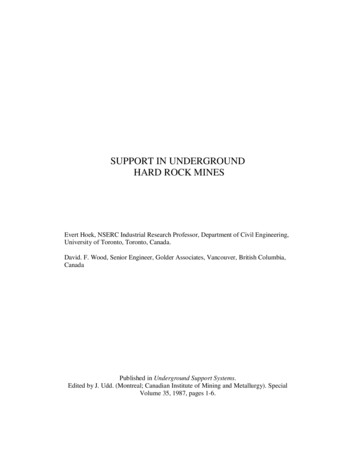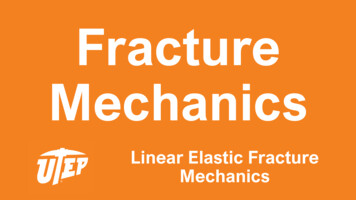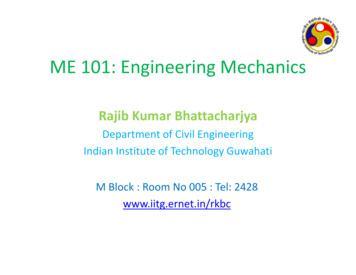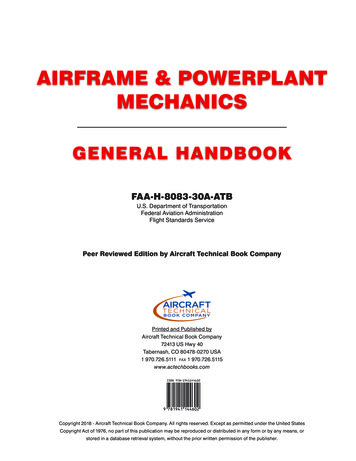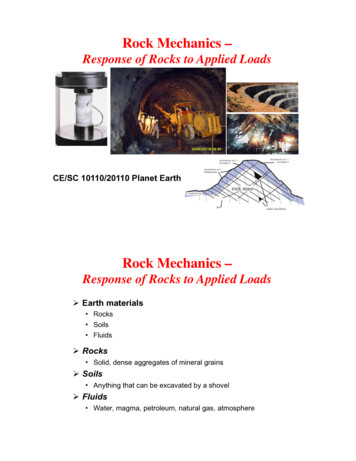
Transcription
Rock Mechanics –!Response of Rocks to Applied Loads!CE/SC 10110/20110 Planet EarthRock Mechanics –!Response of Rocks to Applied Loads!! Earth materials Rocks Soils Fluids! Rocks Solid, dense aggregates of mineral grains! Soils Anything that can be excavated by a shovel! Fluids Water, magma, petroleum, natural gas, atmosphere
Phase Relationships in Earth Materials!! Rocks can be considered as three-phase systems in mostcases Solid, liquid, gas! Most rocks contain some void space between grains Voids are always filled with some type of fluid - either liquid or gas Amount of void space & amount and type of fluid influencemechanical behavior of the material! Porosity and void ratio - parameters used to quantifyrelative amount of void space Porosity (%)n Vv / VTVv Void volume, VT Total rock volume Void ratio (decimal)e Vv / VsVv Void volume, VS Volume of solidsPhase Relationships in Earth Materials!Permeability - rate at which fluids will move through a saturated material! Determined by size and connectedness of voids, and fluid properties(temperature, viscosity, density)! Intrinsic permeability, k (cm2 or darcys) - permeability defined by theproperty of the material Size, shape, packing of the grains Degree of cementation Degree of fracturing! Hydraulic Conductivity, K (cm/s, m/s) - measure of the ability of arock or soil to transmit water K k*[(ρg)/µ]k intrinsic permeabilityρ density of waterµ viscosity of waterg acceleration due to gravity4
Permeability and Hydraulic Conductivity!(Brief Summary)!! High porosity and permeability materials have highhydraulic conductivity! Importance? Wells, oil deposits, reservoirs .UnfracturedIgneousLow kLow KShaleLow kLow KKarstlimestoneHigh kHigh KGravelHigh kHigh KStress, Strain, Deformation Characteristics!! Pressure - force per unit area applied to solid by a load! Stress - pressure transmitted from the external face toan internal location, also force per unit area! Types of stresses Compressive - stresses of equal magnitude that act toward apoint from opposite directions Tensile - stresses of equal magnitude that act away from apoint Shear - stresses that are offset from one another and act inopposite directionscompressive!tensile!shear!6
Stress, Strain, Deformation Characteristics!! At any point within an object Stresses can be resolved into three principle stressesthat are mutually perpendicular (σ1, σ2, σ3) Maximum, intermediate and minimum stress! On any plane within an object There is a normal stress (σn)perpendicular to the planeand shear stress (τ) actingparallel to the plane7Stress, Strain, Deformation Characteristics!! Vertical stress σv acting on a horizontal plane atshallow depth h can be calculated as:σv γh Paγ unit weight of rockh depth to point below surfacePa atmospheric pressure (usually neglected) This equation assumes a consistentbody of rock above point If multiple layers of different rock types σ v γ a h a γ b h b γ ch c 8
Stress, Strain, Deformation Characteristics!! Previous equation can be applied if we wish todetermine the stress on the major (horizontal) principleplane.
Stress, Strain, Deformation Characteristics!! What if we want to know the stress on an inclinedplane? Mohr s CircleMohr Circle:Graphical representation of shear andnormal stresses on inclined planes
Stress, Strain, Deformation Characteristics!13Deformation - Response to Stress!! Application of stress causes a body of rock to yield ordeform.! The amount of deformation is called strain! The type and amount of strain that a particularmaterial experiences depends on: Type of stresses applied Depth and temperature14
Deformation - Response to Stress!Ideal Materials! Elastic (e.g. spring) Linear regression on a plot of stress vs strain Slope of regression line is modulus of elasticityE σ/ε ; σ applied stress; ε strain Strain is change in length vs original length ε ΔL / L Strain in elastic systems is recoverable15Deformation - Response to Stress!Ideal Materials! Viscous (fluids) Linear regression in a plot of stress vs strainrate Viscosity is slope of regression line in a stressstrain rate plot! Plastic No strain until some critical stress value hasbeen reached; then continuous deformation16Fig. 7.11 textbook
Deformation - Response to Stress! Rock behavior is more complex than ideal materials Common method of testing rock behavior is theunconfined compression test17Deformation - Response to Stress!Generalized stress-strain curve for rocks Stress/strain relationships are generally not linear Usually show 3 distinct segments:Region 1:closing of void spacesRegion 2:approximately elastic behaviorRegion 3:approximately plastic behaviorFailure:rock breaks and loses all shearstrength18
Deformation - Response to Stress!! Different types of rocks vary considerably in theirstress-strain behavior! Two types of responses Brittle - respond in a mostly elastic fashion untilfailure Ductile - respond elastically until the “Elastic Limit”,then in plastic fashion until failure19Compressive Strength!! Failure of a brittle rock - point when the rock loses allresistance to stress and crumbles.! In plastic material, specific point of failure difficult toidentify - because deformation continues indefinitelyat a constant level of stress.! Strength (in plastic materials) – is defined as thelevel of stress at failure.20
Compressive Strength!! On a plane within a rock body Normal stresses tend to resist failure Shear stresses tend to cause failure If shear stress exceeds the shear strength - failure occurs21Compressive Strength!! Relationship between shear and normal stressesduring a strength test (and at failure) is critical tounderstanding deformation behavior of the material! Way to test shear strength - Direct shear testVariable shear and normal stresses can be applied22
Compressive Strength!! For unconsolidated materials (e.g. dry sand) therelationship between normal stress (σn) and shearstrength (S) is linear, passes through the origin:S σn tan φ23Compressive Strength!! For consolidated materials or cohesive soils,relationship also linear, but there is inherent shearstrength due to interparticle bonding (cohesion - C):S C σn tan φφ Angle ofinternal friction24
Compressive Strength!! Confining Pressure Weight of overlying rock applies pressure in all directionsto given body of rock - confining pressure Not always equal in all directions Underground mine, tunnel construction! Triaxial test Confining pressure can beapplied to better mimicdepth conditions25Large triaxial press, used fordeformation experiments andmaterials testing26
Compressive Strength!! Confining Pressure (cont d)Varying principle stresses (both axial and confining)allows for creation of multiple Mohr’s Circles andDefinition of the failure envelope27Compressive Strength!! Effect of increasing confining pressure Rocks change from brittle to ductile behaviorDuctile response dominant beyond 700 kg/cm2 Strength of rock increases with increasing confining pressure28
Compressive Strength!! Effect of increasing temperature Strength decreases with increasing temperature Ductile response occurs at lower pressures (stress) underhigher temperatures! Effect of time Stress applied in geologic systems occurs over millions ofyears Rock strength decreases with decreasing strain rate (applysame amount of strain over a very long period of time)29Tensile Strength!! Tensile strength resistance to failure under tensilestress! Typically much lower than compressive strength 10% of compressive strength typical (Table 7.2)! Horizontal rock beams can be dangerous because ofthe weak tensile strength – rock unit must behomogeneous and composed of resistant minerals! Arches overcome this by transferring tensile stress tocompressive stresses around the arch30
31Engineering Classifications of Rock and Rock Masses– Properties are determined in hand samples and inthe field– Rocks are almost always weaker in the field thanin lab tests – some reasons why are Heterogeneity of the bulk samplesFracturesBedding planesZones of weaknessOthers?32
Engineering Classification of Rock and Rock Masses!! Intact Rock Strength classification is based on strength of the rock(compressive strength & modulus of elasticity; Table 7.2) 5 strength classes: A-E based on the overall rock strength;A very strong, E very weak(Table 7.3) Any discontinuities, fractures, bedding planes, etc. willstrongly influence overall strength of the rock. 6 stiffness classes (Table 7.4): based on modulus of elasticityEt50; ‘very stiff’ to ‘highly yielding’33!Engineering Classification!Stress!! Determining the modulus of elasticity Et50Slope of the line tangent at 50% of the !unconfined compressive strength Et50!50%!Strain!! Plotting Et50 value of a rock vs the unconfinedcompressive strength gives a visual comparison of thestrength and modulus values of different rocks.! MR Et50 / σa (unconfined compressive strength) Modulus Ratio – Deere and Miller Classification34!
E: very low strength – A: very high strength!8!Very stiff4!2!highly yielding!Modulus of elasticity Et50 (kg/cm2) x 105!Deere and Miller Classification!1!0.5!125! 250! 500! 1000! 2000! 4000!Unconfined compressive strength σa (kg/cm2)!35!Figure 7.28Intact Rock Classification - Igneous rocks!E: very low strength – A: very high strength!8!Blue intrusive!Red extrusive!4!2!1!0.5!Very stiff - highly yielding!Modulus of elasticity Et50 (kg/cm2)! Intrusive: high modulus of elasticity/medium modulus ratio! Extrusive: greater variability!125! 250! 500! 1000! 2000! 4000!Unconfined compressive strength (kg/cm2)!
Intact Rock Classification - Sedimentary rocks!Extremely variable strength and modulus properties! Clastic rocks Depends upon grain size, grain size distribution, sorting,packing, cement type, lithification processes! Nonclastic rocks Depends upon composition Limestones/dolomites generally medium to high strength andmodulus ratios Evaporites tend to be much weaker37!E: very low strength – A: very high strength!8!Very stiff - highly yielding!Modulus of elasticity Et50 (kg/cm2)!Blue limestone/dolomite!Red sandstone!Orange shale!4!2!1!0.5!125! 250! 500! 1000! 2000! 4000!Unconfined compressive strength (kg/cm2)!38!
Intact Rock Classification - Metamorphic rocks!E: very low strength – A: very high strength!8!4!2!1!Blue marble!Red quartzite!Black gneiss!Orange schist!0.5!Very stiff - highly yielding!Modulus of elasticity Et50 (kg/cm2)! Tend to increase strength due to recrystallization and compaction! Marbles may be weaker than limestones due to bigger grain size!125! 250! 500! 1000! 2000! 4000!Unconfined compressive strength (kg/cm2)!39!Rock Mass Properties and Classification!! Rock strength and modulus properties determined on smallintact hand samples - does not necessarily match field conditions! Weakest link principle overall strength of a rock notdetermined by bulk properties, but by strength of weakest link! Rock discontinuities Depositional discontinuitiesFracturesBedding planesFoliationCleavageFaultsContactsDikes, sills, veinsFaults40!
Rock Mass Properties!! When rock mass undergoes stress, it will preferentially failalong existing planes of weakness rather than develop newfractures.! Must know the spacing, orientation, roughness of these weaklinks in order to accurately assess strength of the rock mass.! Many variations and it s impossible to know them all for anyrock mass.! Assessment of the quality of rock massRQD - Rock Quality Designation, Table 7.7Total recovery of drill core and length of intact pieces High recovery and long pieces indicate solid unfractured rock Low recovery and crumbled pieces indicate highly fractured rock Example: 10 m long core: 9.2 m recovered in pieces that were 10 cm inlength or longer, thus RQD 92%41!Rock Mechanics SummaryResponse of Rocks to Applied Loads.Phase Relationships in Earth Materials: Porosity and Permeability;Void Ratio; Intrinsic Permeability; Hydraulic ConductivityStress, Strain, Deformation Characteristics: Stress – Compressive,Tensile, Shear; Normal Stress; Shear Stress; Vertical Stress.Mohr’s Circle.Deformation – Response to Stress: Strain; Elastic, Viscous, Fluid,Brittle, Ductile, Elastic Limit; Unconfined Compression Test;Generalized Stress-Strain Curve for Rock.Compressive Strength: Strength; Shear Strength; Direct Shear Test;Confining Pressure; Triaxial Test; Definition of the FailureEnvelope.Tensile Strength.Engineering Classifications of Rock and Rock Masses: Deere &Miller.Rock Mass Properties & Classification: Weakest Link Principle; RockQuality Designation (RQD).42!
Rock Mechanics –! Response of Rocks to Applied Loads! CE/SC 10110/20110 Planet Earth Rock Mechanics



